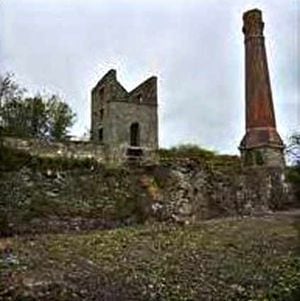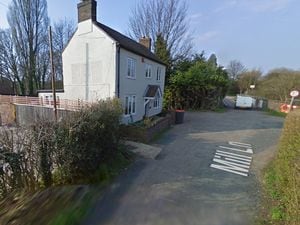Four historic Shropshire sites added to English Heritage 'at risk' list
More historic sites across Shropshire have been declared "at risk" by English Heritage, bringing the total number in the county to 91.

The four new entries on English Heritage's register of sites in danger of deterioration and decay are the Nag's Head engine house at Pontesbury, Tankerville Lead Mine at Pennerley, and Lord Hill's Column and a section of Town Walls, both in Shrewsbury.
In the West Midlands area there are now 424 sites on the register, and English Heritage is campaigning to get them renovated and restored.
Buildings already on the register include Wattlesborough Castle at Alberbury, Hargreaves Farm House in Wollaston, which dates from the early 17th century, Snailbeach Smelt Mill which was built in 1862 for the Snailbeach Mining Company and the Candle House, Snailbeach, where miners collected candles before going underground.
The former Ditherington Flax Mill in Shrewsbury is still listed as being of "immediate risk or further rapid deterioration or loss of fabric", even though campaigners have now secured £12million to restore it.
In total there are 29 Grade I or Grade II* buildings deemed to be at risk in Shropshire, 48 scheduled monuments – ranging from a moated fishpond at Upton Magna to a Roman villa at Pontesbury, three Grade II parks or gardens and two conservation areas.
Sarah Lewis, principal Heritage at Risk Advisor for English Heritage, said: "Shropshire is very different in its landscape – it is a very rural county yet was at the heart of the Industrial Revolution.
"Scattered across the county are Roman villas, Offa's Dyke, medieval castles, Tudor town houses and buildings from the industrial revolution.
"There are also many groups involved in the maintaining of this heritage, from the Friends of Ditherington Flax Mill and the Friends of the Lord Hill Column to Shropshire Mines Trust and The Stiperstones & Corndon Hill Landscape Partnership scheme as well as Shropshire Council. We will try to work as closely as possible with them to secure funding."
The four new sites:
Nag's Head Engine House at Pontesbury has recently been marked as at "immediate risk of further rapid deterioration or loss of fabric".
The engine house, which stands on the Pontesford coalfield, is in very bad condition with ivy invading the building and overhanding trees adding an additional threat.
The monument, which has scheduled status, has been identified as part of a project in the Stiperstones and Corndon Hill Landscape Partnership. A grant from English Heritage has funded a survey of the site as well as a repair programme and discussions will now be sought with the owner although no solution has yet been agreed.
The engine house was on the Pontesford coalfield which provided coal for the Pontesford lead smelters which served the south Shropshire lead mines.

The Town Walls in Shrewsbury which were built in the 13th century as a defensive fortification for the town from the Welsh have been affected by weather and traffic and a repair is being co-ordinated by Shropshire Council.
The walls, made of sandstone, are one of the main routes into Shrewsbury town centre. At one point there is a large stone tower which is the last remaining medieval watchtower on what were the fortified defensive walls of Shrewsbury. The tower dates from the 14th century, a time when the town was still subject to attacks from the Welsh. Like Shrewsbury Castle the tower was a means of observing the land around the town and the River Severn. The condition of the scheduled monument, which also has Grade II listed building status, is described as 'fair' but showing slow decay.

Lord Hill's Column in Shrewsbury was erected in 1816 to commemorate Rowland Hill as a premier general in the Napoleonic Wars who was Wellington's second in command at Waterloo.
Over the years the column and statue have been damaged by the weather.
Lord Hill's Column is the tallest Doric column in England, standing at 133ft 6in (40.7m) and is described as being in a "poor" condition.
The architect of the Grade II* building was Edward Haycock Snr, with modifications mainly to the pedestal by Thomas Harrison. The pedestal is square with a pier of buttress at each angle, on which are placed recumbent lions, worked of Grinshill stone by John Carline, of Shrewsbury. The statue of Lord Hill was modelled in Lithodipyra (Coade stone) by Joseph Panzetta who worked for Eleanor Coade.
The first stone was laid on December 27, 1814, by the Salopian Lodge of Free Masons assisted by deputies from adjoining lodges, on the festival of St John the Evangelist. The last stone was laid on June 18, 1816, the anniversary of the Battle of Waterloo. The total cost was £5,972.

Tankerville Lead Mine, at Pennerley. Comprising of an engine house, chimney, ore hoppers, crushing and dressing floor.
Tree and scrub growth covers the walls.
An English Heritage grant has been offered for the repair of the walls and work should be completed in 2014.
A solution to the problem has been agreed but not implemented.
Major features including the engine house and shaft were consolidated in 1996 thanks to an English Heritage grant aid.
The condition of the scheduled monument is considered to be very bad with ivy and trees encroaching on the site.





